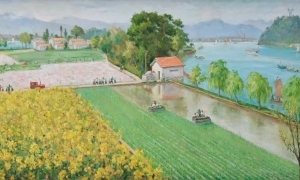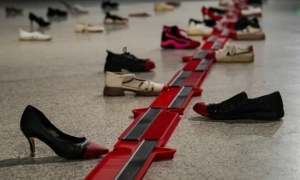看到武明中的作品,会被其炫目而刺激的色彩所震惊,时尚而简约的造化所冲击。武明中惯用红色,红色作为其作品中主人公的内核而存在,在这里,一种颜色被赋予特殊的使命,物化成承载延展武明中艺术意图的具体存在,以液体的形式被浇注在武明中一切感兴趣的物质内部,使得这些本来透明、空洞的物体变得有分量感,化身成艺术家手中的容器,至于它要被装点什么,一切只能听从艺术家的安排;武明中画面中大面积的红色运用,也表达着艺术家内心世界的扩张,但这种扩张巧妙的被安排在生活中常见的物象之中,这是艺术家面对纷繁无序的现实社会无奈感、矛盾心理以及自我调侃的表达。时尚而真实的现实物象在武明中的画笔下变得不真实和虚拟化,我们可以感受到武明中与社会现实的明确联系,但是这些联系和逻辑却在他的画面中被艺术家有意的打乱了,他将它们塑造成一个个树脂的器皿,或者干脆是一些没有实际功能的树脂摆设,加上红色的“血液”,真实世界中存在的物体被武明中幻化成虚拟图像,在这一系列的虚拟物象和视觉结构中,我们可以观察到武明中对现实的独特关注和理解以及超现实的艺术表达,感受到一种不真实但很有压迫感的气场,尽管它们都是透明和易碎的,但正是这种虚拟化、人工化的材质可以给人们更丰富多元而又暧昧的感官联想。
说武明中的作品,必须谈谈他的人。我之前并不熟悉他本人,只是在别处见到过作品。他是一位教授,从武明中的作品中能感受到他的学理修为,这是和许多艺术家不一样的地方。武明中的作品承担着象“老一辈”艺术家作品“教科书”似的使命,尽管他的作品画面总是荡漾一些青春萌动的气氛,从形式语言上也很容易被年轻一代所认同和识别,但是我想,武明中还是更希望他的作品能有所指,因此他尽量营造了让其作品能指的可能性。可以说武明中走的是一条观念绘画的道路,这与他的生活经历和学识背景有着密不可分的关联。
武明中绘画的突出特征是它的语言形式。红色的树脂物象已经无可厚非的成为了武明中的艺术标签。一方面,武明中有意识的挑选了现实生活中那些无意义的物体,比如说小便器、红酒杯等等,这些人们生活中司空见惯的物品在武明中手中精心的被营造成无意义的透明器皿,从这一点上看,武明中似乎希望将自己抽离于真实的现实之外,想要冷眼旁观,但又逃离不了真实现实的窠臼,因此他只能选择日常生活中熟悉的东西来借以发挥,并干脆将这些看似无聊的东西嬉笑化,娱乐化。可以说这是新一代知识分子表达面对社会现实急速剧变从而内心世界产生空前变化的新型方式。它是一种积极的喜笑怒骂和超女式的点评,而不是一味消极的批判和自我沉沦。另一方面,武明中还有喜欢调侃历史人物,将他们塑造成树脂的里程碑,本身这种方式就带有了武明中式的幽默。人物形象自身就蕴含了话语能力,有点穿越时空来到当下现实的错觉感,它们都是由树脂浇注而成,他的教育和历史意义在这里被Q化的解构了,变成一个摆设,可以看出武明中有意将经典变得娱乐,将历史变成当下的企图心。
我认为,树脂是武明中绘画永远的内核。似乎所有画面中都有树脂物体的存在。我更愿意称它们为“树脂体”而不是“玻璃体”,因为树脂比玻璃有更多的可阐释性,它同样“易碎”,但它比玻璃似乎更为模糊和虚拟,更具有凝结时代意义的特性。其材质本身就已经赋予了它自身更多的意义,就像武明中的作品一样。“树脂”是一种状态不确定,但很有质感的物质,它透明却又实在,能捧在手心,却又感觉虚无缥缈,因为它是如此透明;它遇热即改变状态,可以重塑成任何形状,当然也能保持原状,蓄发各种能量和生命,可以说树脂是一种“变态”的物质,这和许多艺术家的创作和生存状态很相似。我们常说某些艺术家很另类变态,可能是莫名的压抑和对未知因素的探求心理以及种种复杂骚动的生理心理情绪,驱使着艺术家创作出可能很沉默但具有内在爆发力的作品,这些作品的形态可能是多变的,看似静如止如固体的树脂,其中蕴藏的力量却很可能是凝结了这个时代的亚文化精神。而可流动般感的质感就像艺术家的思绪一样成为创作的源泉。种种这些树脂的特征都为武明中所用,他用树脂来塑造他感兴趣的一切事物,给很多无意义的场景和事物看似浅薄,易碎,但又富含无限张力的生命力。
皮力先生是这样评论武明中的艺术的:“当历史与政治人物的物化成为艺术家的观念之后,画面的视觉样式就开始发生变化了。如果洞悉艺术家潜在的观念,我们就很难将这些绘画归结为我们熟悉的表现或者写实形态的绘画。武明中绘画的语言是在在于放弃固有的语言趣味,而绝对追求绝对虚拟出来的物象的质感。在这些画面中,我们看不到表现或者写实形态艺术所强调的画面本身的笔触,而是被对象本身的质感所刺激。”皮力先生的分析充分而精确的说明了武明中绘画在语言和观念上的突破,武明中正是用物化的观念形象来揭示历史和现实的本质,其作品中解构和复制的特性为武明中的想象世界和现实世界搭起了桥梁。
从武明中的一系列新作中,我们看到他对当下现实生活更为宏观和直接的表达。如《吃吧》系列中,武明中运用大量排比和并置的方法将画面中武明中式的观念形象充斥到极限,完全用树脂、红色的物象作为他手中的棋子来布局画面,巨幅的作品加之几乎无限的物象,使观众几乎要窒息,画面达到了从微观到宏观,再从宏观到微观的通达效果。这一切都反映了中国社会特别是都市化进程,政治、经济飞速发展状况下,人们生活产生急剧变化的现实写照。当然,武明中的方法是非写实的,是观念和抽象的,但从这些新作来看,武明中对现实的关注远远超过了以往。可以说,我们可以看到武明中的艺术创作从语言上和观念上达到一个统一的高峰。语言已经成为观念的一部分。也许,树脂正是武明中的独特语言,也是他的艺术观念所在,是联系现实和武明中自我世界的结点。
Resinic Reality
Liu Chunfeng
Looking at Wu Mingzhong’s painting, viewers are stimulated and shocked by its dazzling colors, a concise and fashionable display that impacts the eye. The red that Wu Mingzhong uses exists as the core in the main characters depicted in his works. Color is given a special mission, extending the specifics of color into the existence of the artist's work. He pours the liquid into every object that he is interested in, so that these transparent and empty objects feel as if they have weight, becoming embodied vessels in the artist’s hands. The artist alone can determine what these vessels are to be filled with. These glasses, bottles and other bizarrely shaped glassware – visual celebrations teetering on vertigo – insistently require that you avoid “clumsy movements” and that you“handle with care”. There is such a latent power in Wu Mingzhong’s recent work that you feel a miraculous and captivating sense of fragility. Amazingly, the colours transcend the canvas and emit a vital visual flame. At once stimulating and stunning, it speaks to the spirit and, set against the background of the canvas, one is able to catch a glimpse of the artist's passionate reflections on contemporary society. He changed his style and began to use glass as an expressive tool in the series. Perhaps his methods are better suited to Platonic reflections on social reality, but once he began the series, there was no going back. Mingzhong became fascinated with glass - its transparency, luminosity and magnificence. His reflections, however, are more immediately concerned with the ingenious ways in which these characteristics can be translated onto canvas.
These figures and wine filled glasses, his vessels and bottles, either deep red or fluorescent pink, have become the visual – and extremely effective – mark of Wu’s questionings into social reality. Beyond polished beauty, a deeply entrenched and worrying message lies in plain sight: a warning or“caution”. Beneath the calm surface, anxiety is present, an underlying current constantly threatening to erupt. Wu Mingzhong’s voice resonates from within this work – one that emanates from the soul. The artist states that “The more beautiful a material is, the more fragile it is." It is the fragility of splendor. Materials these days are all about beauty, flash and power. People are in search of consumption, luxury and pleasure. They might as well be, but that search and an excessive dependence on material things robs humanity of their independence and their capacity for originality.
Material things will never solve the problem of man’s vulnerability. On the contrary, it will only serve to aggravate it. Man, originally a creature of flesh and blood, no longer exists. He is nothing more than a being made of glass and he does not belong: he is left with only the material contents of glassware and that which is refracted toward the exterior world. Glass and alcohol are two characteristics of our age. "I paint men made of glass to express the fragility inherent in contemporary reality," says the artist, "the fragility of the relationship between man and himself as well as with others and the environment.” After an extended period of research and observation, Wu Mingzhong finally found the material best adapted to the expression of his vision – glass. He tirelessly rendered its texture, integrated within the rest of his artistic ventures, explored it and sought out its multiple capabilities. He does so to a point where his cultural language and intellectual orientation seem to say: social reality is paradoxical in every respect. Overflowing with splendor, it is also fragile and dangerous, and nothing in the universe is beyond the reach of its entrapment. We are reminded of a dream and then we awake to realize that the reality in which we live is fragile, that the environment is fragile, that feelings, daily life, sincerity between individuals are all fragile.
We have made a transition from a society of political fragility to one that is mercantile and even more fragile still. The ultra-consumerism promoted by multinational capitalism is vertiginous and agonizing even as it disrupts and destroys. Confronted by reality, in politics as in life, artists can no longer allow themselves to remain dilletantes. Lyricism, likewise, is out of the question. The artist's only recourse is to attempt to escape the trap of paradox. But to flee (that is to say to distance oneself from) our monstrous and chaotic reality, that is easier said than done. Who can forget the “dead silence” that followed, twenty years ago, with the explosion of the space shuttle Challenger? Or the endless reflections on the nature of “vulnerability” that were triggered by the thick smoke of September 11th? Presently, the global rise in temperatures shows us once again, as if it were still necessary, to what degree the existence of the human species is fragile and the extent to which our environment is in a constant state of deterioration. The friend that sits at the negotiating table today may be the enemy who takes up arms against us tomorrow. In order to reap rewards, interest groups from powerful nations manage to perpetuate insurrection in Palestine, Israel and the Gulf: how often have the hopes of those whose goal is peace been torn to shreds as a result? Of course, Wu Mingzhong does not address these issues directly, but his visual iconography is a glaring confirmation of the vulnerability of individuals and of reality.
Whether or not the spectacle sets off a spark of desire or of yearning within the brain is of little importance. On the contrary: the point is to demonstrate how our lives gradually disappear beneath an accumulation of “pretty things”. They also cause us to recognise the fragility and ambiguity of such relationships - the slightest rupture. An incredible amount of prudence must be taken in our treatment of others, of their gender. Relationships must be contemplated with circumspection. Without a doubt, they are fragile and dangerous, the epitome of the universal constraints and vulnerabilities of the human species. An open challenge to the moral standards present in our daily lives. while it is curiously redundant and literary, still does not cause us to recoil. On the contrary, in contemporary art, imitation and the corruption of the classics constitute a means of re-addressing linguistic elements.
From the works of Wu Mingzhong, we see a direct and grand contemporary narrative forming. In series like Eat It, the character has become so well known that he no longer requires explanation. It highlights the complexity of society, the heterogeneous nature of our existence within that society and, as such, questions anew the ethical norms of an age that has become ever more vulgar and superficial. As for determinism in art history, the psychological and cultural suggestiveness present in his work situates him at the heart of the matter. Behind his dizzying images, it seems to hint at something more dangerous and poignant. Humanity would live in a state of perdition. The constant latent possibility of the destruction of the world is evoked, once again allowing Wu Mingzhong to charm us with his incessant search for perfection and his masterful sensitivity toward contemporary artistic form. In this world of glass, politics are combined in evermore ingenious ways. Wu Mingzhong faintly blurs the line between the interior and exterior universe. Perhaps, resin forms a unique language in the work of Wu Mingzhong, serving as a concept in his art, a node that links the inner world of Wu Mingzhong to the real world.
【编辑:霍春常】






















